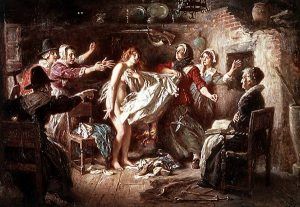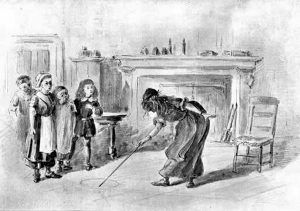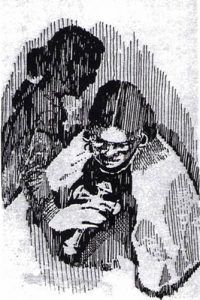Witches of Salem: Index A B C D E F-G H I-J K-N O-P Q-S T U-Z
Mary Harrington Taylor (16??-1733) – The daughter of Richard and Elizabeth Harrington, Mary would grow up to marry Seabred Taylor on November 21, 1671, and the couple would have seven children. She was accused of afflicting Mary Marshall of Malden, Massachusetts, and was examined on September 5, 1692. She was friends with Lydia and Sarah Dustin, who had already been arrested and imprisoned, which more than likely led to her accusation. Mary Marshall would say that Mary Taylor had hurt her by witchcraft and tried to persuade her to worship the Devil. Also testifying against her was Mary Foster Lacey, Sr. During the examination, several girls in the room would fall if Mary looked at them, including Hannah Post, Susan Post, Mary Warren, and others. Mary Taylor was also accused of having a hand in the death of William Hooper, who had died in a house fire. Mary Taylor was indicted for witchcraft on January 31, 1692. However, she was later released.
Margaret Webb Sheaf Thacher (1625-1694) – Proving that no one was immune from witchcraft accusations, the mother-in-law of Magistrate Jonathan Corwin was also accused of witchery. Margaret was born in Boston in 1625 to Henry and Dorabell Smith Webb. She grew up to marry Jacob Sheaf in September 1642. The couple would have two children. Jacob died in Boston on March 22, 1658. Margaret’s father and her husband, Jacob Sheafe, had business interests in Maine and New Hampshire, and Margaret Thacher retained control of some of their property. She also held extensive holdings in Boston, including her home and acreage next to Governor William Phips’ house. Several years after her first husband’s death, she married the Reverend Thomas Thacher. From 1669 to his death in 1678, Thacher served as the founding minister of the Old South Church. Working for Margaret in 1692 was a woman named Mercy Short. When the maidservant began to come down with fits and other strange behavior, she accused her mistress of afflicting her with witchcraft. Margaret Thacher, known as a woman of great piety, was never charged, but Mercy Short would spend some time behind bars after confessing to witchcraft herself. Margaret’s daughter Elizabeth was married to Magistrate Jonathan Corwin. Margaret Thacher died in Boston on February 23, 1694.
Tituba (1665?-??) – The first person to be accused of practicing witchcraft during the Salem witch trials, Tituba was a slave who belonged to the Reverend Samuel Parris. While living in Barbados in the 1670s, Parris purchased Tituba and another slave named John Indian. Tituba was originally from an Arawak village in South America, where she was captured as a child and taken to Barbados into slavery. She is thought to have been between 12 and 17 years old when Parris purchased her. When Parris moved to Boston in 1680, the two slaves accompanied him. Parris soon married Elizabeth Eldridge, and the couple would have three children. The family moved to Salem Village in July 1689, where Samuel Parris became the minister. That same year, Tituba and John Indian were married and remained a part of the Parris household. The slaves were thought to have had only one child, which they named Violet.
When Elizabeth Parris and Abigail Williams began to show their odd “afflictions,” Tituba was the first person they accused of witchcraft. Unfortunately, she had made herself a likely target for witchcraft accusations. Shortly after Elizabeth “Betty” Parris began having strange fits and symptoms, she prepared a “witch cake” to reveal the identity of Betty’s afflicted. Reverend Samuel Parris was enraged when he found out about the cake, and shortly after that, the “afflicted girls” named Tituba a witch.
Tituba first denied that she had anything to do with witchcraft but was soon coerced into confessing to having spoken with the Devil, as well as other wild tales about black dogs, a yellow bird, red and black rats, and other animals, as well as her riding sticks to various places. She was also the first person to confess to witchcraft in Salem Village. She accused other women, including Sarah Solart Poole Good and Sarah Warren Prince Osborne, whom the children had also named as witches, as her accomplices. She even went on to say that Sarah Osborne possessed a creature with the head of a woman, two legs, and wings.
Rumors were rampant that Tituba had enthralled the local teenage girls with her stories of African or Caribbean voodoo and magic spells, and she had taught Elizabeth Parris and Abigail Williams the forbidden practice of fortune-telling. However, nowhere in the court records has confirmed this was true. The girls’ fortune-telling technique was nothing more than an egg white in a glass of water, a commonly known device in New England at the time. She also said she was beaten by her owner, the Reverend Samuel Parris, and was told to confess to witchcraft. Interestingly, she confessed to all being culturally European, not African or Caribbean.
Even though she confessed to a capital offense and was a slave, Tituba was never tried or executed for her role in the witchcraft trials. By confessing early on, Tituba avoided the ordeal of going to trial, joining with the “afflicted girls” in providing key evidence against accused witches. When public sentiment towards the accusers and the trials began to change, Tituba recanted her confession, which enraged Reverend Samuel Parris. In retaliation, he refused to pay the jailer’s fee to get her out of prison, and she spent 13 months in jail until an unknown person paid the seven pounds for her release and bought her. The same person likely bought her husband, John, because Puritans were not inclined to split up married couples, even slaves. What happened to her after she began her life with her new owner is unknown.
Job Tookey (1665-??) – A laborer in Beverly, Massachusetts, Tookey was accused by Mary Warren, Susanna Sheldon, Ann Putnam, Jr., Sarah Bibber, Mary Walcott, Elizabeth Hubbard, and Elizabeth Booth on June 4, 1692. All the “afflicted girls” would say he had tormented them. Mary Warren would also say that Tookey was the cause of several deaths, utilizing poppets that he stabbed in the heart. Mary Walcott and Elizabeth Booth would echo these charges by stating that they had seen the apparitions of dead people crying out for vengeance. Job Tookey must also have been a somewhat boastful man, as several people would testify as to things he had said, such as how he could freely discourse the Devil, that he would take the Reverend George Burroughs apart, and that he was not the Devil’s servant, but that the Devil was his. In the end, he was indicted in September and sent to prison. However, for whatever reason, he was not immediately tried. In January 1693, he was tried and found not guilty. He was ordered discharged after paying his fees.
Margaret Toothaker (1682-??) – The daughter of Roger and Mary Allen Toothaker, Margaret was born in Billerica, Massachusetts, on January 31, 1682, the youngest of nine children. Margaret was just ten years old when she was arrested along with her mother, Mary Allen Toothaker, for witchcraft. The complaint, made by Joseph Houlton and Jonathan Walcott of Salem Village on May 28, 1692, allegedly stated that she and her mother had afflicted Mary Walcott and Abigail Williams. No records of any examination of her survive, but she is referred to in several court records. Interestingly, her name never appears. Instead, she was referred to repeatedly as the daughter of her father or mother or even as a cousin, but never as an individual. Her father, Roger Toothaker, who was also accused, died in prison shortly after Margaret’s arrest. Margaret Toothaker was the only child of two accused parents, witches. The ten-year-old appears never to have been indicted but remained in prison with her mother, Mary, for over seven months. Her mother was tried in January 1693 and found not guilty. Margaret was released with her mother. In the meantime, the Toothaker homestead had been burned by Indians. Margaret and her mother returned to the remains of their home. However, their turmoil was not yet over. On August 5, 1695, Indians attacked their small town of Billerica. Some 15 people were killed, including Mary Allen Toothaker. Margaret, who was 12 years old at the time, was kidnapped and never seen again.
Mary Allen Toothaker (1642?-1695) – The wife of Roger Toothaker, who was already in prison on a charge of witchcraft, Mary would also be arrested, along with her ten-year-old daughter, Margaret. Mary was born in about 1642 in Andover to Andrew and Faith Ingalls Allen. She grew up to marry Roger Toothaker on June 9, 1665, and the couple eventually had nine children. Her husband, a folk healer who claimed to be able to hunt and get rid of “witches,” was arrested for witchcraft in May 1692. Soon, Mary and her ten-year-old daughter, Margaret, would also be accused. Upon a complaint by Joseph Houlton and Jonathan Walcott of Salem Village on May 28, 1692, for allegedly afflicting Mary Walcott and Abigail Williams. Both were brought in and imprisoned in Salem Towne. When questioned, she would admit that her husband, Roger Toothaker, had skills in practicing countermagic against witches and confirmed that her daughter, Martha Toothaker Emerson, had killed a witch. Mary would also be accused by her seven-year-old niece, Sarah Carrier, and Elizabeth Johnson Jr.
Just a few weeks later, on June 16, Mary’s husband, Roger Toothaker, died in prison. Mary’s daughter, Martha Toothaker Emerson, was arrested and jailed six days later. On July 30, Mary Toothaker was examined and confessed to practicing witchcraft. She was deathly afraid of Indians because their homestead was far from the center of town. Stating that she had many dreams of fighting with them, she had yielded to the Devil, who promised her they would not hurt her. She said she had signed the Devil’s book and had been a witch for about two years. She would also admit to attending a witches’ meeting where others were present and that the Reverend George Burroughs was the leader. She implicated Mary Green and Hannah Varnum Tyler Brumidge of Haverhill and Ann Alcock Foster of Andover, as well as others.
Mary had good reason to be afraid of the Indians. Just two days after her examination, on August 1, her hometown of Billerica was attacked, and six people were killed. A couple of days later, the Indians returned and burned down the deserted Toothaker farm. On August 5, 1692, Mary’s sister was condemned by the Court of Oyer and Terminer, and on August 10, she was hanged at Salem Towne. In the meantime, Mary and her daughters remained in prison. The Superior Court of Judicature finally tried her at Charlestown at the end of January 1693. Both she and her daughter, Martha Emerson, were found not guilty. Mary’s daughter, Margaret Toothaker, was never tried but was also released. Mary and Margaret returned to their burned-out home. Mary Toothaker had been through hell. But, her terror was not yet over. On August 5, 1695, her worst fear came true when Indians attacked the small town of Billerica again. Some 15 people were killed, including Mary Allen Toothaker. Her daughter, Margaret, who was 12 years old, was kidnapped and never seen again.
Roger Toothaker (1634-1692) – A doctor, Roger Toothaker, was charged with witchcraft and died in prison. He was born in England on November 27, 1634, and he traveled with his parents to America when he was just a baby. When he was only four years old, his father, also named Roger, died in 1638, and a year later, his mother remarried a man named Ralph Hill. The couple settled in Billerica. When Roger grew up, he served as an assistant to another physician and later became a doctor himself, though he had no formal training. In about 1660, he was given a lot of land by his stepfather, Ralph Hill, located in the northern part of Billerica. On June 9, 1665, he married Mary Allen, daughter of Andrew and Faith Allen of Andover and sister of Martha Allen Carrier. The couple would eventually have nine children.
Roger Toothaker was known to have practiced a natural form of medicine, making him more of a “folk healer.” He also claimed that he specialized in detecting and punishing witches. For several years before the Salem witch trials began in 1692, Toothaker had bragged to locals that he had taught his daughter, Martha Emerson, wife of Joseph Emerson, his trade and that she had killed a witch by boiling her urine in a pot overnight. Despite his claims of being a “witch hunter,” or perhaps because of them, a warrant for his arrest was issued in May 1692 for allegedly having afflicted Elizabeth Hubbard, Ann Putnam, Jr., and Mary Walcott of Salem Village. Roger was then sent to prison in Boston. Later that month, another complaint would be filed against his wife, Mary Allen Toothaker, and their ten-year-old daughter, Margaret, who were imprisoned in Salem Towne. Roger Toothaker died in the Boston jail on June 16, 1692, before he could come to trial. Though a full inquiry was conducted into his death, and it was determined he died of natural causes, many found it suspicious. After his death, his grown daughter, Martha Toothaker Emerson, would also be arrested. The rest of his family would spend some time in prison, but all were spared the hangman’s noose.
© Kathy Alexander/Legends of America, updated January 2024.
Also See:
The Salem Witchcraft Hysteria (Main article)
Procedures, Courts & Aftermath



